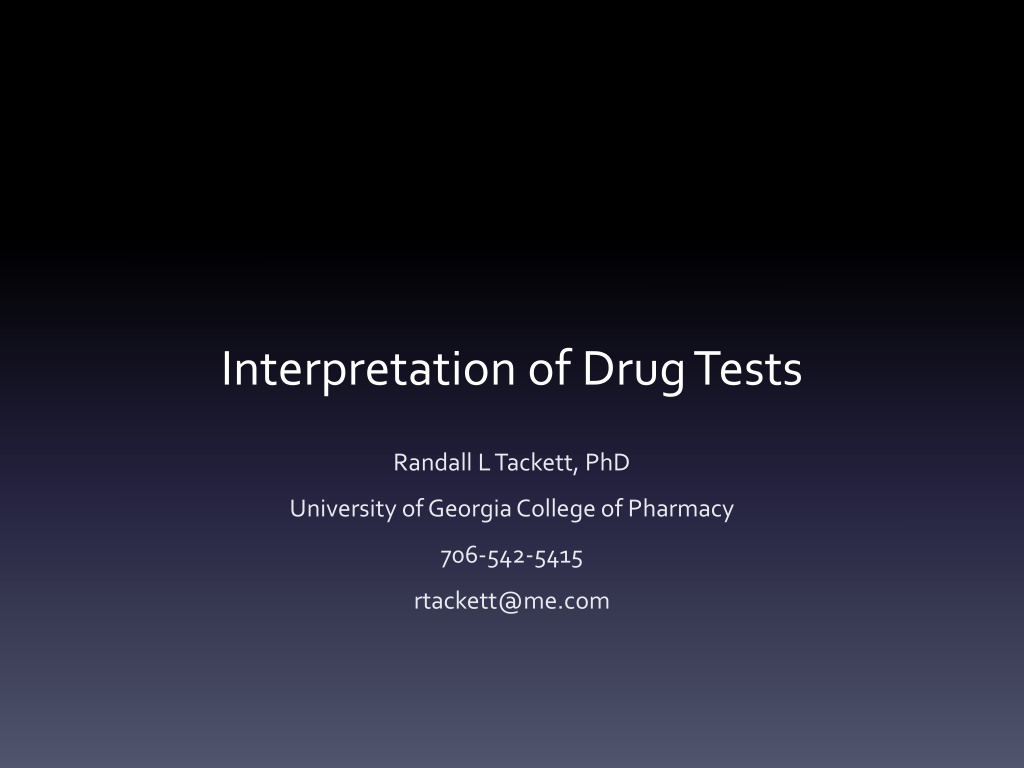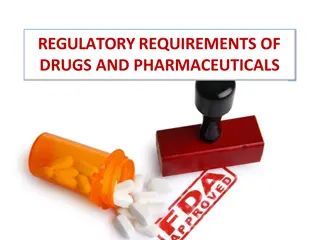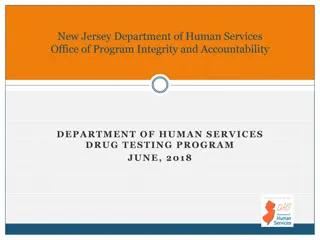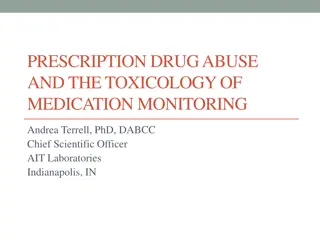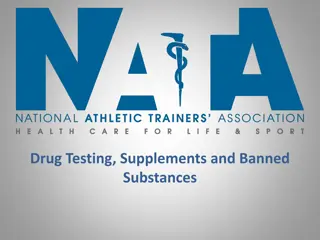Understanding Drug Testing: Insights and Considerations
Drug testing interpretation is not always straightforward as the correlation between drug levels and impairment varies. Different types of tests, such as EMIT and GC/MS, provide different levels of detail and accuracy. Cut-off values are specified by SAMSHA, and testing for alcohol can be subject to various interferences. Understanding the nuances of testing conditions and the types of substances tested is crucial for accurate interpretation.
Download Presentation

Please find below an Image/Link to download the presentation.
The content on the website is provided AS IS for your information and personal use only. It may not be sold, licensed, or shared on other websites without obtaining consent from the author. Download presentation by click this link. If you encounter any issues during the download, it is possible that the publisher has removed the file from their server.
E N D
Presentation Transcript
Interpretation of Drug Tests Randall L Tackett, PhD University of Georgia College of Pharmacy 706-542-5415 rtackett@me.com
Drug Testing The basic assumption is that a blood or urine drug level is directly correlated to a level of impairment. Reality: This is not always the case
Type of Test Drug Screen (EMIT, RIA) Positive if above a cut-off Negative if below cut-off Does not provide quantification Highly subject to interferences Confirmation test GC/MS Fingerprint of drug Identifies specific drug and quantitates
Cut-off Values Substance Abuse and Mental Health Services Administration (SAMSHA) specifies cut-off values SAMSHA requires 5 drug categories to be routinely included in urine screens Amphetamines (methamphetamine, amphetamine, MDMA) Cocaine metabolites Marijuana metabolites Opiate metabolites (morphine, codeine, 6-actylmorphine) Phencyclidine In specific cases, cutoff values may be lowered
Type of Test Hospital vs Forensic Testing Generally a screen Not intended to quantitate Usually has a disclaimer on lab report that results should not be used for legal purposes
Type of Testing Hospital alcohol testing Measures alcohol dehydrogenase based assay Usually is measuring serum or plasma rather than whole blood Subject to interferences Other alcohols Lactate and LDH (lactate ringer s solution; muscle damage) Varies with test
Testing Conditions Calibration of instrument Appropriate standards Standard curves Linear? Sample between calibrators
What was tested? Breath Blood Serum Whole blood Urine
What was tested? Whole blood vsSerum (ethanol) Serum contains a greater water content than whole blood Since ethanol distributes in water content, greater ethanol concentration in serum than whole blood Whole blood alcohol concentration = serum alcohol concentration/1.14
What was tested? Urine Longer period of detection If in urine, not acting in tissue Metabolite Active vs inactive
Characteristics of Specimens Urine window of detection typically 1-5 days; Can be adulterated Shy bladder Hair longest window of detection Usually 90 days based on collection of 1.5 in of hair (0.5 in/month) Non-invasive Expensive Will not detect recent use (7-10 days prior to test)
Characteristics of Specimens Saliva reflects recent use (10-24 hrs) Noninvasive Drugs and metabolites do not remain in sample long Limited value Sweat limited value Few labs perform test
Administration Route of administration How long has patient taken drug Is patient taking drug regularly Therapeutic window Winek Basalt
Detection Times -Urine Drug DetectionTime Amphetamine 2-5 days, possibly 2 weeks with heavy use Cocaine metabolites (benzoylecgonine) Up to 2 weeks; 6 weeks w/chronic use LSD 1-2 days Marijuana metabolite (COOH) 7-10 days; 1 month chronic use Opioids 2-3 days Methadone 3-14 days PCP 2-10 days
Tolerance Tolerance is dynamic it increases and decreases Varies between individuals Tolerance affects both the therapeutic effects and toxic effects of a drug
Is drug prescribed? Was the drug prescribed for the person or someone else s medication? When was it prescribed old vs current prescription? Drug interactions
Are clients symptoms consistent with drug? What symptoms of impairment were noted at the time of arrest? Are they consistent with pharmacology of drug Alternative explanation for behavior noted?
Interpretation of Drug Tests Indicates that drug has been ingested Unlikely to be able to relate to level of impairment Usually not able to determine when most drugs were ingested Requires confirmation test Screening test not sufficient for determining exposure 21
Type of testing? Summary Testing conditions? What was tested? Administration Tolerance Is drug prescribed Symptoms consistent with pharmacology
